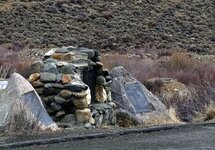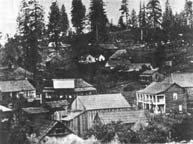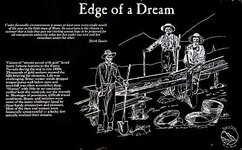pegleglooker
Bronze Member
- Jun 9, 2006
- 1,857
- 238
- Detector(s) used
- ace 250
- Primary Interest:
- All Treasure Hunting
This is coooollll
PLL
Located in northern California, Dogtown was established as a gold mining camp shortly after the 1849 California gold rush on a ridge overlooking the West Branch of the Feather River Canyon.
One of the earliest known written accounts describing Dogtown was the made after the journey of Robert Stuart and his two sons, Granville and James, who left Iowa in 1852 to seek their fortunes in the California gold fields. After arriving in California they traversed the American Valley continuing on through Bidwell's Bar in Butte County; then on through Morris Ravine near Cherokee; finally arriving at Sam Neal's rancho near present day Durham, California.
Granville Stuart recorded his first impressions of Neal's rancho and Dogtown...
"We spent a week at Sam Neal's ranch in the Sacramento Valley, but as every meal we ate cost each of us one dollar, James and I determined to leave and go up into the mountains to the gold mines. We went sixteen miles up in the foothills to a little village on the ridge between the West Branch of the Feather River and Little Butte Creek. This little village was known as Butte Mills, because there was a sawmill nearby run by water power from Little Butte Creek, but it soon got its proper and well deserved name of Dogtown, for although there were only ten houses, there were sixteen fully developed dogs."
There was a reason why so many dogs had made their appearance in the area. It seems that a Mrs. Bassett had reached the area following the Oroville-Susanville highway on foot. She had neither horse nor wagon and her entire possessions consisted of three dogs of uncertain ancestry - two females and one male.
When she reached the ridge overlooking the West Branch of the Feather River she decided to pitch her tent and try her luck. Mrs. Bassett was a tough old gal but she was no miner and had to find other ways to get by. Fortunately, soon after she arrived, her pups multiplied and saved the day.
Most of the men who came to California in the early days came with other men or they came alone, leaving their families thousands of miles behind. These men became quite lonely and longed for some sort of companionship.
Recognizing the needs of the homesick miners, Mrs. Bassett sold her puppies to the local miners for one large pinch of gold dust each. Soon every cabin in the area had a canine companion. There were dogs in the stores, dogs in the saloons, dogs everywhere!
It's no wonder then, that strangers to the area would remark upon their arrival, "This must be Dogtown!"
Up until 1859 Dogtown was known only to the locals and most probably preferred it that way. But in April 1859 a gigantic 54 pound gold nugget was discovered on the slopes of Sawmill Peak just across the canyon of the West Branch of the Feather River from Dogtown. Up to that time it was the largest gold nugget ever discovered in the world. News like that travels fast.
Dubbed the "Dogtown Nugget," the discovery made headlines in newspapers all across the United States and started a small gold rush to the area. It seemed at the time that the name "Dogtown" would never be forgotten. But things change...
As the area grew and the miners found more gold, some decided to stay and make the place their home. They sent for their wives and families and began to settle in.
Unfortunately for "Dogtown," the women who came were not too pleased with the name. An item appeared in the Marysville Appeal on August 16, 1860 from one of the discontented wives of Dogtown:
"We should hate to live in a place called "Dogtown," particularly if we had a large correspondence and had to write the name frequently."
Accordingly, in 1862, the female residents of Dogtown demanded that the name be changed and the community was renamed "Magalia," the latin word for "cottages."
So there you have it! Dogtown became Magalia and the women had their way. Some things never change. . .
Note: Although most people called the town Magalia after 1862, the area was still referred to as Dogtown by many old timers until the turn of the century. (Bachelors, I suppose!)

PLL
Located in northern California, Dogtown was established as a gold mining camp shortly after the 1849 California gold rush on a ridge overlooking the West Branch of the Feather River Canyon.
One of the earliest known written accounts describing Dogtown was the made after the journey of Robert Stuart and his two sons, Granville and James, who left Iowa in 1852 to seek their fortunes in the California gold fields. After arriving in California they traversed the American Valley continuing on through Bidwell's Bar in Butte County; then on through Morris Ravine near Cherokee; finally arriving at Sam Neal's rancho near present day Durham, California.
Granville Stuart recorded his first impressions of Neal's rancho and Dogtown...
"We spent a week at Sam Neal's ranch in the Sacramento Valley, but as every meal we ate cost each of us one dollar, James and I determined to leave and go up into the mountains to the gold mines. We went sixteen miles up in the foothills to a little village on the ridge between the West Branch of the Feather River and Little Butte Creek. This little village was known as Butte Mills, because there was a sawmill nearby run by water power from Little Butte Creek, but it soon got its proper and well deserved name of Dogtown, for although there were only ten houses, there were sixteen fully developed dogs."
There was a reason why so many dogs had made their appearance in the area. It seems that a Mrs. Bassett had reached the area following the Oroville-Susanville highway on foot. She had neither horse nor wagon and her entire possessions consisted of three dogs of uncertain ancestry - two females and one male.
When she reached the ridge overlooking the West Branch of the Feather River she decided to pitch her tent and try her luck. Mrs. Bassett was a tough old gal but she was no miner and had to find other ways to get by. Fortunately, soon after she arrived, her pups multiplied and saved the day.
Most of the men who came to California in the early days came with other men or they came alone, leaving their families thousands of miles behind. These men became quite lonely and longed for some sort of companionship.
Recognizing the needs of the homesick miners, Mrs. Bassett sold her puppies to the local miners for one large pinch of gold dust each. Soon every cabin in the area had a canine companion. There were dogs in the stores, dogs in the saloons, dogs everywhere!
It's no wonder then, that strangers to the area would remark upon their arrival, "This must be Dogtown!"
Up until 1859 Dogtown was known only to the locals and most probably preferred it that way. But in April 1859 a gigantic 54 pound gold nugget was discovered on the slopes of Sawmill Peak just across the canyon of the West Branch of the Feather River from Dogtown. Up to that time it was the largest gold nugget ever discovered in the world. News like that travels fast.
Dubbed the "Dogtown Nugget," the discovery made headlines in newspapers all across the United States and started a small gold rush to the area. It seemed at the time that the name "Dogtown" would never be forgotten. But things change...
As the area grew and the miners found more gold, some decided to stay and make the place their home. They sent for their wives and families and began to settle in.
Unfortunately for "Dogtown," the women who came were not too pleased with the name. An item appeared in the Marysville Appeal on August 16, 1860 from one of the discontented wives of Dogtown:
"We should hate to live in a place called "Dogtown," particularly if we had a large correspondence and had to write the name frequently."
Accordingly, in 1862, the female residents of Dogtown demanded that the name be changed and the community was renamed "Magalia," the latin word for "cottages."
So there you have it! Dogtown became Magalia and the women had their way. Some things never change. . .
Note: Although most people called the town Magalia after 1862, the area was still referred to as Dogtown by many old timers until the turn of the century. (Bachelors, I suppose!)






